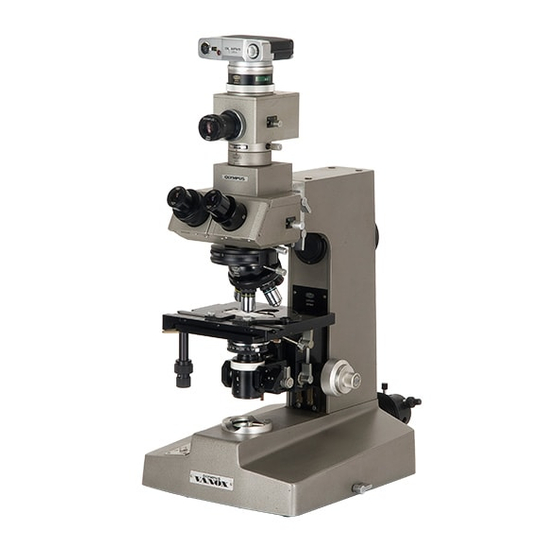Olympus VANOX Instruction Manual - Page 21
Browse online or download pdf Instruction Manual for Microscope Olympus VANOX. Olympus VANOX 28 pages. Universal research microscope

E.
Condenser
Achromatic/Aplanatic Condenser (N. A. 1 -40)
EXCELLENT RESOLVING POWER
*
Has
extremely high resolving power and will give
the operator satisfactory results even when used dry.
"
Proves
best i t s
excellence when oil-~mmersed.
*
Whenusingobjectives100X,thecondensershould
be immersed. The condenser
can
be used with
all objectives from 4 X and up. Oblique illumina-
tion will further improve resolving power.
1. Oblique
l ll urnination
Resolving power
can
be doubled.
As against the normal (central] illumination where
the
light beams are parallel to the optical axis of the
microscope, oblique illumination provides light bundles
a t an
angle to the oprical axis.
Resolving power increases
The illuminating light proceeds from below with
an
in thisdirection.
inclination t o the specimen, which will cause not only
the normal transmitted beam but also the refracted
light
to
enter the objective. This will double the resolv-
ing power as compared with central illuminatian.
ST.
/
: ; ;
F i
n g
The drawing on the right hand side illustrates oblique
decreases
illumination system.
$ * ,
in this
The
cross
hatched area represents the cone ot
direction.
light.
C:
Optical axis
Cd:
Condenser
flS
Ob:
O h j ~ r t i v ~
r:
Iris
diaphragm
/ ' -
/ -
a
a:
Article
t o
be
identified
S:
Sliding direction
of
iris
2. Procedure
1 )
Stop dawn the aperture iris diaphragm.
2)
Loosen the clamping screw and pull out the aperture diaphragm with the
slide
lever. The direction of diaphragm displacement should be a t right angles to the
specimen detail t o
be
observed.
For example, if
it
is desired to identify two parallel details very close t o each
other
as two separate lines, the aperture diaphragm
is
moved at right angle
ro
the details.
If identification of two points
is
desired,
the
diaphragm is moved
parallel t o the straight line connecting the two points.
3)
Adjustment of the diaphragm slide and diaphragm diameter while looking through
the
eyepiece resolves the two lines
or
points and permits very deMi led observation
of
the structure.
3. Observation of Overall Area Possible
Oblique illumination is effective only when the illuminating l ~ g h t is directed a t right
angles to the specimen.
In order t o identify individual specimen details, therefore, it i s necessary to adapt
the direction of diaphragm displacement perpendicular t o the direction of the specimen
detail to be observed.
Diaphragm rotation through 1
50°
is
possible
with
the achromaticlaplanatic condenser.
Stage
rotation provides further possibility of diremional adaptation.
